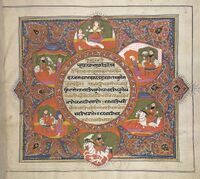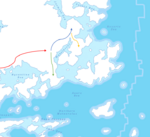History of Central Orient: Difference between revisions
No edit summary |
No edit summary |
||
| Line 6: | Line 6: | ||
===Prehistoric Orient (Before c.3300 BCE)=== | ===Prehistoric Orient (Before c.3300 BCE)=== | ||
====Paleolithic==== | ====Paleolithic==== | ||
[[File:Oriental Migration Map.png|thumb|150px|right|A map of the basic early Oriental migration .]] | |||
Modern {{wp|humans}} began migrating to the central Oriental region from [[Amutia]] and [[Azania]] with the earliest appearing in modern-day [[Mahana]] and [[Namdatka]]. Evidence suggests that some then migrated into [[Kotowari]] and [[Mekabiri]], and finally from [[Mekabiri]] into [[Tamurin]]. | |||
====Neolithic==== | ====Neolithic==== | ||
=====Ghobari Valley Civilisation===== | =====Ghobari Valley Civilisation===== | ||
Revision as of 11:51, 12 June 2022
| Part of a series on |
| Central Orient |
|---|
 |
This article is incomplete because it is pending further input from participants, or it is a work-in-progress by one author. Please comment on this article's talk page to share your input, comments and questions. Note: To contribute to this article, you may need to seek help from the author(s) of this page. |
The term "Central Orient" defines itself as a region of the Oriental sub-continent containing countries such as Kotowari,Tamurin,Mekabiri,Mahana and Namdatka. The region also goes by other names such as the Kotowaran sub-continent or the Menelassar Bay region. The regions history is heavily intertwined with other countries outside the region such as Orioni and colonial powers from Argis such as Delamaria. Central Orient has historically had powers in Tamurin and Kotowari, which both had holdings over the rest of the region.
Timeline
Prehistoric Orient (Before c.3300 BCE)
Paleolithic
Modern humans began migrating to the central Oriental region from Amutia and Azania with the earliest appearing in modern-day Mahana and Namdatka. Evidence suggests that some then migrated into Kotowari and Mekabiri, and finally from Mekabiri into Tamurin.
